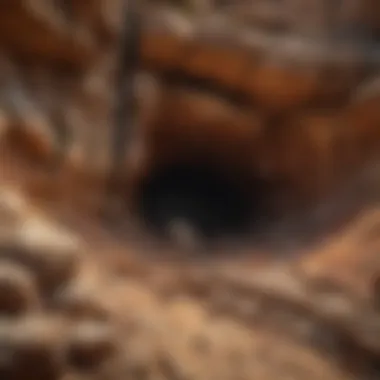Unlocking the Mysteries of Identifying a Rock: An In-Depth Exploration


Rock and Fossil Identification
Delve deep into the intricate world of rock and fossil identification, where each specimen holds a tale of geological history waiting to be deciphered. Understanding the types of rocks and fossils is a fundamental pillar in this pursuit, from igneous to sedimentary to metamorphic formations. Each category bears distinct characteristics, such as color, texture, and mineral composition, which are crucial for accurate identification. Moreover, examining fossils requires a keen eye for intricate patterns and structures that provide clues to past life forms embedded in rocks. To aid in this exploration, specialized tools like rock hammers, magnifying lenses, and UV lights prove invaluable, enabling enthusiasts to inspect specimens with precision and detail.
Collecting Tips and Techniques
Embark on a journey to uncover the best practices for collecting rocks and fossils, a venture that requires a delicate balance of enthusiasm and caution. Locating prime collecting sites involves research and exploration, scouting for regions rich in geological diversity and historical significance. Once at a site, knowing how to safely extract specimens is essential to preserve both the rocks and the environment. Techniques such as careful chiseling, proper digging methods, and minimizing impact on surrounding ecosystems are vital considerations for responsible collecting. By adhering to these practices, collectors can contribute to the preservation and sustainability of geological treasures for future generations.
Preservation and Display
After the thrill of collecting comes the art of preservation and display, where rocks and fossils transform into curated exhibits of natural wonders. Techniques for preserving specimens range from cleaning with delicate brushes to applying protective coatings that maintain their integrity and luster. Proper storage methods, such as utilizing airtight containers and moisture control agents, ensure longevity and prevent deterioration over time. When it comes to creative display ideas, imagination takes center stage. From elegant glass cases to interactive dioramas, showcasing rock and fossil collections can turn a hobby into a visually captivating journey through Earth's history.
Geological Insights
Venture into the heart of geological insights, where the Earth's narrative unfolds through ancient formations and dynamic processes. Discover the historical significance of rocks and fossils, where each discovery sheds light on past environments, climates, and life forms. Delve into notable discoveries in the field, from dinosaur fossils to preserved plant imprints, unveiling the mysteries of our planet's past. Explore geological formations shaped by tectonic forces, sedimentation, and erosion, understanding the ever-evolving canvas upon which rocks and fossils are imprinted. By immersing oneself in these geological wonders, enthusiasts gain a profound appreciation for the interconnectedness of Earth's history and the intricate beauty found within its rocky layers.
Introduction
Rock identification is a critical skill in the geological realm, serving as the gateway to unraveling the mysteries embedded in the Earth's crust. This article embarks on a journey to illuminate the intricate process of discerning rock types, shedding light on the essential techniques, characteristics, and tools requisite for accurate identification. Embracing the nuances of mineral composition alongside the tangible attributes of rocks, readers will embark on a captivating exploration into the heart of geology.
Understanding Rock Identification
The Significance of Rock Identification
Delving into the realm of rock identification unveils a realm of significance that reverberates throughout geological studies. At the core, rock identification serves as the linchpin for understanding the Earth's history, composition, and evolution. Its pivotal role lies in deciphering the intricate tapestry of Earth's geological past, paving the way for a profound comprehension of our planet's story. In this article, the emphasis on rock identification elucidates the fundamental role it plays in bridging the gap between theoretical geology and practical applications, making it an indispensable asset for rock and fossil enthusiasts.
The Relationship Between Geology and Rock Identification
The intrinsic link between geology and rock identification underscores the symbiotic relationship between the two disciplines. Geology provides the contextual backdrop against which rock identification thrives, offering a holistic perspective that delves into the geological underpinnings of rock formations. By delineating this interconnection, readers gain insight into how geological processes shape rock characteristics, enriching their understanding of the dynamic Earth processes captured within each rock specimen. This synergy between geology and rock identification amplifies the depth of knowledge garnered, fostering a comprehensive grasp of the geological realm.
The Importance of Accurate Rock Classification


Accurate rock classification stands as the cornerstone of geological studies, underpinning the foundation upon which precise interpretations are built. In the realm of rock identification, the importance of classification lies in its role as a precise taxonomy that categorizes rocks based on their distinct attributes. By ensuring accuracy in rock classification, researchers and enthusiasts alike can derive meaningful conclusions about geological histories, mineralogical compositions, and environmental conditions. The meticulous nature of accurate rock classification imparts a level of precision that elevates the scientific rigor of geological studies, ultimately enriching the discourse surrounding rocks and their defining characteristics.
Overview of Rock Types
Igneous Rocks
Igneous rocks, born from the fiery depths of Earth's core, stand as testaments to the volcanic processes shaping our planet. Their[remaining text truncated for brevity]
Physical Features
Color and texture
The color and texture of rocks are key physical features that provide valuable insights into their mineral composition, formation history, and environmental conditions. By examining the color and texture of a rock sample, geologists can make initial observations about the presence of certain minerals, rock types, and geological processes that have influenced the rock's appearance. Color variations in rocks can indicate the presence of specific mineral compounds, such as iron oxides (red, yellow), carbonates (white, gray), or sulfides (black, metallic), while textures like grain size, shape, and fabric can reveal information about the rock's cooling history, sedimentary origin, or metamorphic recrystallization.
Key Characteristic: The key characteristic of color and texture in rock analysis is their visual impact and interpretive significance in identifying rock types and distinguishing mineralogical variations. Colors and textures reflect the mineral content, grain size, and structural features of rocks, offering valuable clues for determining their origin and geological context.
Unique Feature: One unique feature of color and texture analysis is the utilization of color charts, hand lenses, and macroscopic observations to document and interpret variations in rock appearance. By combining color and texture assessments with mineralogical analyses, geologists can paint a holistic picture of the rock's characteristics, origins, and potential geologic processes that have shaped its present-day state.
Crystal shape and size
Analyzing the crystal shape and size of rocks provides geologists with essential information about the rock's mineral composition, crystallization history, and tectonic conditions. Crystals in rocks can exhibit diverse shapes and sizes depending on the mineral structure, growth conditions, and geological processes that influenced their formation. By describing crystal shapes (e.g., cubic, prismatic, acicular) and sizes (microscopic, coarse-grained), geologists can infer details about the rock's cooling rate, pressure-temperature conditions, and mineral growth mechanisms, enhancing their understanding of the rock's origin and evolutionary path.
Key Characteristic: The key characteristic of crystal shape and size analysis lies in its ability to reveal the crystalline nature of minerals and provide clues about the rock's genetic processes, such as igneous crystallization, metamorphic recrystallization, or mineral alteration. Crystallographic features like cleavage planes, twinning, and crystal habits convey essential information about mineral properties, structural relationships, and geologic environments.
Unique Feature: One unique feature of crystal shape and size examination is the integration of crystallographic analyses with mineralogical investigations to establish mineral relationships, growth sequences, and paragenetic associations within rocks. By studying crystal forms and dimensions in conjunction with physical features and mineral occurrences, geologists can construct detailed mineralogical models and infer the dynamic evolution of rock-forming processes over geological time scales.
Layering and banding
Layering and banding in rocks reflect distinct geological processes, depositional environments, and rock-forming events that have influenced the development of layered rock sequences. These structural features can arise from sedimentary layering, metamorphic foliation, igneous layering, or tectonic deformation, providing geologists with clues about the rock's original stratigraphy, deformation history, and geotectonic settings. By studying layering and banding patterns, geologists can interpret past sedimentary sequences, mountain-building events, or magmatic processes that have shaped the rock's fabric and structure over geological time scales.
Key Characteristic: The key characteristic of layering and banding analysis is their stratigraphic significance and structural implications for rock interpretation. Layered structures, such as bedding planes, foliation, or gneissic banding, reflect the sequential accumulation of sediments, the metamorphic alignment of minerals, or the magmatic layering in igneous rocks, revealing valuable information about the rock's tectonic history and deformational processes.


Unique Feature: One unique feature of layering and banding investigation is the correlation of layer sequences and band patterns with regional geology, paleoenvironmental reconstructions, and geological mapping, enabling geologists to reconstruct the depositional history, structural evolution, and tectonic events that have shaped the rock's architecture. By examining layering and banding features in detail, geologists can unravel the complexities of Earth's dynamic geologic processes and interpret the rocky record of past environments and events with precision and insight.
Field Methods for Identification
In this comprehensive guide on unlocking the mysteries of identifying a rock, the section on Field Methods for Identification plays a crucial role in equipping readers with practical techniques for accurate rock identification. Understanding the significance of adopting efficient field methods is paramount in the process of rock identification. Field methods provide collectors and enthusiasts with hands-on tools and strategies to conduct on-site observations and analyses, leading to more precise identifications. By emphasizing field methods, this article empowers readers to engage directly with their findings and make informed decisions based on real-time assessments of rock characteristics and properties.
Observation and Analysis
Field Notes and Documentation
Field notes and documentation are essential components of the rock identification process, serving as a detailed record of observations made in the field. By meticulously documenting key features such as location, formation, color variations, and accompanying minerals, collectors can establish a comprehensive reference for future analysis and comparison. The primary benefit of field notes lies in their ability to capture nuanced details that may be overlooked during initial observations, enhancing accuracy in rock identification. Although time-consuming, the practice of maintaining thorough field notes proves invaluable in reconstructing geological contexts with precision.
Use of Hand Lens or Magnifier
Integrating a hand lens or magnifier into field observations elevates the level of detail accessible to collectors, allowing for closer inspection of mineral grains, textures, and structural integrity within rocks. The key characteristic of using optical aids like hand lenses lies in their capacity to reveal subtle features that are not readily visible to the naked eye, enhancing the capacity to identify specific minerals or rock types accurately. While portable and user-friendly, hand lenses may have limitations in magnification power, requiring collectors to supplement their toolkits with additional equipment for microscopic analyses.
Testing Properties like Hardness and Reaction to Acid
Evaluating the properties of rocks through tests for hardness and reactions to acid offers a systematic approach to rock identification. Testing the hardness of a rock sample using tools like a Mohs scale allows collectors to assess the mineral composition and relative durability of the specimen. Similarly, observing the reaction of a rock to acid aids in discerning its chemical composition and potential mineral content. The unique advantage of these tests lies in providing empirical data that can corroborate visual assessments, enhancing the precision of rock identification methods. However, caution must be exercised to conduct tests safely and responsibly, considering the potential risks associated with handling reactive substances.
Geological Context
Stratigraphy and Rock Layering
Exploring the stratigraphy and layering of rocks unveils valuable insights into their geological history and formation processes. The key characteristic of stratigraphy lies in the systematic arrangement of rock layers, reflecting distinct periods of deposition and environmental conditions throughout geological time. By carefully analyzing rock layering patterns, collectors can infer the sequence of events that contributed to the current rock formations, aiding in identifying potential sediment sources and tectonic influences. While stratigraphy offers a roadmap for reconstructing past environments, variations in layer consistency and composition may present challenges in interpreting complex geological structures.
Fossil Identification in Rocks
The presence of fossils in rocks provides a window into prehistoric ecosystems and evolutionary timelines, enriching the narrative of rock identification with biological significance. Identifying fossils embedded within rocks enables collectors to date geological formations, discern paleoenvironmental conditions, and recognize ancient flora and fauna species. The unique feature of fossil identification lies in its interdisciplinary nature, bridging the fields of paleontology and geology to paint a comprehensive picture of Earth's geological heritage. However, difficulties may arise in accurately identifying fragmented or indistinct fossils, necessitating collaboration with experts for precise classifications.
Regional Geology Influences


Understanding the regional geological influences on rock formations elucidates the broader context in which specific rock types occur and interact with surrounding landscapes. The key characteristic of regional geology lies in recognizing the geological forces and tectonic events that shape the distribution and composition of rocks within a given area. By studying regional geology, collectors can grasp the dynamic relationships between geological formations, mineral deposits, and topographical features, offering insights into the evolution of landscapes over time. While regional geology enhances the interpretive framework for rock identification, variations in local geology may introduce complexities in correlating specific rock types with overarching geological processes.
Advanced Techniques and Resources
Advanced Techniques and Resources play a pivotal role in unraveling the complexities of rock identification. In the realm of geology, utilizing advanced techniques and resources enhances accuracy and provides deeper insights into rock composition and origins. By incorporating cutting-edge methods, researchers and enthusiasts can elevate their understanding and proficiency in rock identification. This section delves into the crucial elements, benefits, and considerations associated with advanced techniques and resources, shedding light on the indispensable tools that shape the rock identification landscape.
Laboratory Analysis
Thin section microscopy
Thin section microscopy stands as a cornerstone in rock analysis, enabling the intricate examination of mineral composition and structure. This technique involves the meticulous preparation of thin slices of rock samples, which are then scrutinized under a petrographic microscope. Thin section microscopy offers unparalleled clarity in identifying minerals, crystal shapes, and textures within rocks. Its high resolution and magnification capabilities make it a preferred choice for detailed mineralogical investigations. Despite its labor-intensive nature, thin section microscopy provides invaluable data for understanding the geological history and formation processes of rocks. Its precise imaging and detailed information are indispensable in the accurate classification of rock specimens.
X-ray diffraction
X-ray diffraction emerges as a powerful tool for analyzing the crystallographic structure of minerals present in rocks. By bombarding a sample with X-rays, this technique produces diffraction patterns, allowing for the identification of mineral phases based on their characteristic crystal lattice arrangements. X-ray diffraction excels in distinguishing between various mineral species and detecting minor mineral components within rock samples. Its non-destructive nature and high sensitivity make it a valuable asset in mineral identification and structural analysis. Despite its reliance on sophisticated equipment and expertise, X-ray diffraction offers unmatched precision and objectivity in characterizing rock minerals.
Spectroscopy
Spectroscopy facilitates the examination of rock composition by analyzing the interaction between matter and electromagnetic radiation. This technique provides valuable insights into the chemical composition, mineralogy, and physical properties of rocks through spectral analysis. Spectroscopy's ability to detect specific elements and mineral bonds enhances the accuracy of mineral identification and characterization. With advancements in technology, various spectroscopic methods such as infrared and Raman spectroscopy have become instrumental in geological research. While spectroscopy requires specialized instrumentation and data interpretation skills, its non-destructive nature and rapid analysis make it a valuable asset in rock identification and mineralogical studies.
Conclusion
Unlocking the mysteries of identifying a rock is a crucial skill for geologists, researchers, and rock enthusiasts. In this article, we have delved deep into the techniques, characteristics, and tools essential for accurate rock identification. By understanding the mineral composition and physical features of rocks, readers can develop a keen eye for different rock types and their origins. The journey of rock identification goes beyond mere visual inspection; it requires meticulous observation, analysis, and sometimes even laboratory testing to unravel the secrets hidden within each rock.
Mastering the Art of Rock Identification
Summary of Key Takeaways
In mastering the art of rock identification, the key takeaway lies in the ability to discern subtle differences in mineral composition and physical features. This skill is paramount in accurately identifying and classifying various rock types, contributing significantly to the reader's overall understanding of geology. The importance of honing this skill cannot be understated, as it forms the foundation for advanced research and exploration in the field of earth sciences.
Continuing Your Rock Identification Journey
Continuing your rock identification journey is a continuous process of learning and discovery. By applying the knowledge gained from this comprehensive guide, enthusiasts can deepen their understanding of rocks and fossils. The journey serves as a gateway to exploring new terrains, uncovering hidden geological wonders, and perhaps even making significant contributions to the scientific community through rock-related research.
Applying Newfound Knowledge in Collecting and Research
Applying newfound knowledge in collecting and research empowers individuals to contribute actively to the world of geology and earth sciences. By utilizing the insights gained from rock identification, enthusiasts can engage in meaningful research projects, expand their rock collection with a deeper understanding of each specimen, and actively participate in the preservation and sharing of geological knowledge. Embracing this hands-on approach to rock identification not only enriches personal collections but also fosters a sense of discovery and scientific inquiry among enthusiasts.







